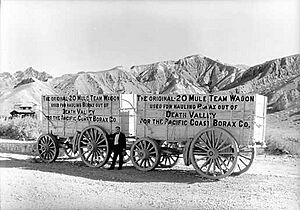Pacific Coast Borax Company facts for kids
The Pacific Coast Borax Company (often called PCB) was a U.S. mining company. It was started in 1890 by Francis "Borax" Smith, who was known as the "Borax King" because he was so successful in the borax business.
Contents
History of the Borax King
The story of the Pacific Coast Borax Company began in Mineral County, Nevada. Francis Smith, who was supplying wood to a small borax mine, noticed a large, flat area called Teels Marsh. He was curious about it.
Smith and two helpers visited Teels Marsh. They collected samples, which showed that the area had more borax than any other known place. Smith quickly claimed the land. This was the start of his career as a borax miner.
In 1872, Smith and his older brother, Julius, began operations. They had financial help from the Storey brothers. Their company was first called Smith and Storey Brothers Borax Co. Later, it became Smith Brothers Borax Co. and then Teel's Marsh Borax Co.
Francis Smith also bought another company, the Pacific Borax Company, in 1880. He worked with a business partner, William Tell Coleman, at the Harmony Borax Works. These different borax interests were combined. In 1890, Smith bought all of Coleman's borax businesses. He then created the new company, the Pacific Coast Borax Co.
Death Valley and Borax Transport
The Harmony Borax Works in Death Valley became part of Smith's company in 1890. To move the borax, the company built the Death Valley Railroad. This railroad ran from Ryan, California, to Death Valley Junction, California. From there, the borax was moved to another train line, the Tonopah and Tidewater Railroad (T&T). This line connected to the main Atchison, Topeka and Santa Fe Railway in Ludlow, California.
You can see a locomotive from the Death Valley Railroad at the Borax Museum in Death Valley National Park.
Other Important Mines
As the mines in Death Valley produced less borax, Smith found new sources. He developed mines in the Calico Mountains near Yermo, California. He built the Borate and Daggett Railroad to transport the borax to the main rail line.
Later, the company found ways to get borax from Searles Lake in the Searles Valley. They built a company town called Westend. They also added a train siding to ship the product to Searles, California.
An early reinforced concrete building in the U.S. was the Pacific Coast Borax Company's refinery. It was built in 1893 in Alameda, California.
Christian Brevoort Zabriskie joined the company in 1885. He became its vice president and worked there until 1933. A famous spot above Death Valley, Zabriskie Point, is named after him.
In 1926, the company created the Death Valley Hotel Company. This new company built a fancy hotel near the Furnace Creek springs. The Furnace Creek Inn opened in February 1927. Guests could travel there by motor-coach from the Ryan train station.
Famous 20 Mule Team Borax
The Pacific Coast Borax Company created and promoted the famous 20 Mule Team Borax trademark. This name came from the 20-mule teams. These teams of mules were used in the 1880s to pull wagons full of borax out of Death Valley. They carried borax from the Harmony Borax Works near Furnace Creek Ranch.
The company also made Boraxo hand soap. They sponsored the Death Valley Days radio show from 1930 to 1951. Later, a TV series of Death Valley Days was hosted by Ronald Reagan, who later became U.S. President.
The Amargosa Opera House
In Death Valley Junction, California, the Pacific Coast Borax Company built a Civic Center in 1923–24. This large building complex cost $300,000. It was designed in the Spanish Colonial Style. It included company offices, a store, a hotel, a dining room, a gym, and an ice cream parlor.
One part of the complex was Corkill Hall. This hall was used for dances, church services, movies, and town meetings. In 1927, the Civic Center became the Amargosa Hotel. In 1967, Corkhill Hall became Marta Becket's famous Amargosa Opera House.
U.S. Borax Today
In 1956, the Pacific Coast Borax Company joined with United States Potash Corporation. They formed a new company called U.S. Borax. In 1967, a larger company called Rio Tinto Minerals bought U.S. Borax.
Today, the company is known as Rio Tinto Borax. It is still a major supplier, providing almost half of the world's borax. In 1988, U.S. Borax sold its well-known products like Boraxo and 20 Mule Team to Dial Corporation.
Rio Tinto Borax still operates the Rio Tinto Borax Mine. This is the largest open-pit mine in California. It is located near the company town of Boron in the Mojave Desert.
The borax operations at Trona later became part of Searles Valley Minerals.


